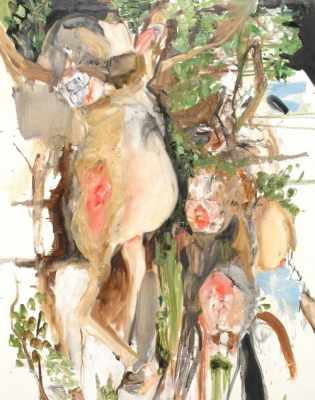Elizabeth Neel STRUNG UP by Arfus Greenwood

A vital fusion of abstraction and representation is shrewdly inter-weft in the paintings of Elizabeth Neel. At Gasser and Grunert, her first New York solo exhibition, is a series of oil on canvas, aggressively gushing from the walls, with titles like Strung Up, Popped Off, Sucked Up and Flushed Out.
On the canvases at once, lush strokes of vivid colour pulled with others, and yet a sudden indication of imagery, equally lush, pushed and pulled, in and out of depth -- fractured trees, a mangled carcass, an abandoned beach bed. But these are not mere nature scenes and still-lifes; Neel unearths disparate visual material from the Internet, where she recovers cultural splinters as diverse as news feeds and discarded clothing. The artist plays with our cognitive recognition to the extent that there is little contrast between the often ambiguous fragmented forms and the juicy vital colours that melt into each other as easily as they shoot out--a kind of deconstructed and then reconstructed nature, where there is an emotional currency of colour, clusters and fields.

Elizabeth Neel, the grand-daughter of the daring 20th century portrait painter Alice Neel, does not rely on references to this figurative tradition; instead the paintings allude to painting--the full force of everything that has come before. And what is exciting to see is that a smart student of her own history has become a smart contemporary artist, with greater promise than even these shown in the exhibition.
Oddly, Neel also creates video works which have been presented at DIVA in Brussels and Volume Gallery in New York City. Together with her brother, Andrew Neel, a filmmaker in his own right, they create filmic studies, suggestive of Edison and the Lumieres, but depicting car crashes or the violence of bull riding. This goes a long way in explaining Neel’s own pop-historical attraction to the tradition of the slaughtered beasts of Rembrandt, Chardin, Soutine and Bacon. A fresh young artist who can utilize such vernacular and give it new life, while honouring the power of its plastic form is a very rare commodity.

It is no surprise that the show has received special attention from the Saatchi Collection and others. After recent surprises at auction, it is difficult to conjecture a definitive trend, but what is clear is a consummate appreciation for artists who have an intimate understanding of history and our own need to reconcile it through its inherent gestures--the artist’s artist will endure.